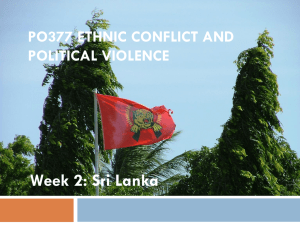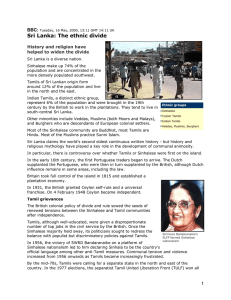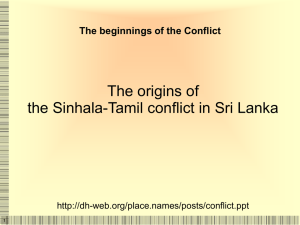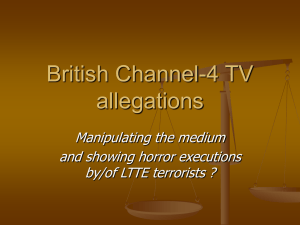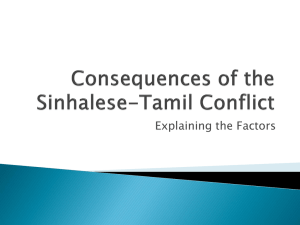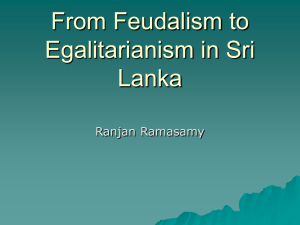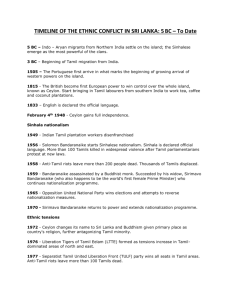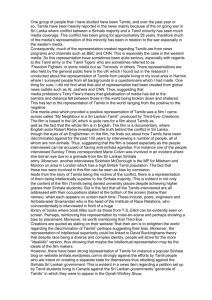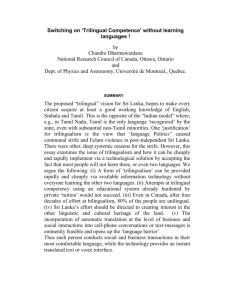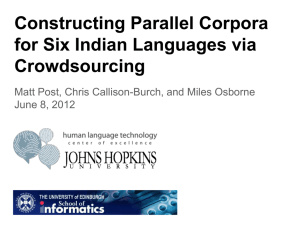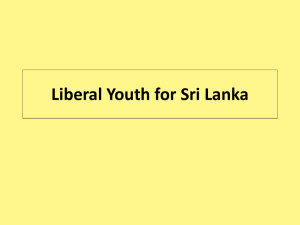Democratic Social Republic of Sri Lanka
advertisement
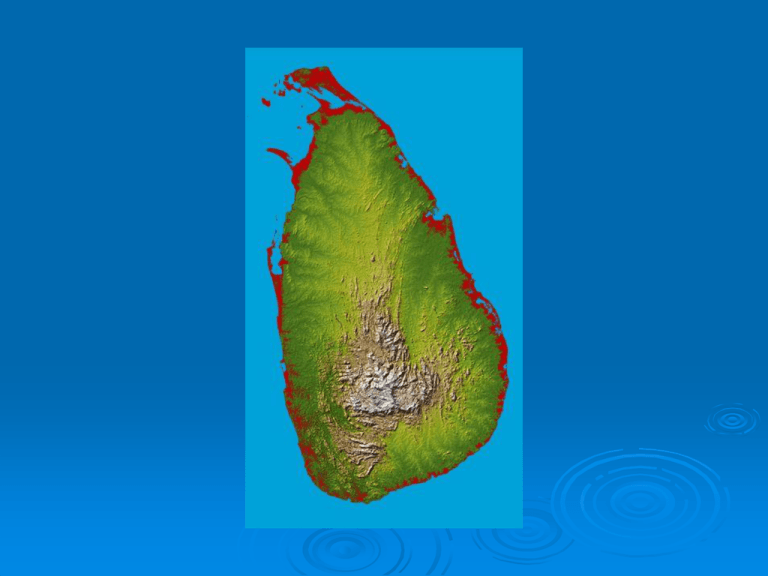
Democratic Social Republic of Sri Lanka Population - 20,000,000 Area - 65,610 sq Km Length - (270 Miles), (432 Km) Width - (140 Miles), (224 Km) Language - Sinhala 74%, Tamil 18% English 8% Administrative division : Province – 9, District -24 Nationals Sinhala Tamil Muslim Berger Malay - 73.8% - 8.5% - 7.27% - 0.3% - 0.2% Religion Buddhist Hindu Christians - 69.1% - 7.1% - 6.2% Colombo Kandy Galle Jaffna Sri Lanka Ethnic Conflict & War IMPORTANT MILESTONE Ceylon gained independence on February 04, 1948. However, it was not complete independence. In terms of the defense agreement entered into between Britain and Ceylon, Colombo, Trincomalee and Katunayake bases continued to remain under British control In 1948, the very year of independence, the Parliament dominated by the majority Sinhalese, enacted the Citizenship Act which reduced the political strength of the Tamils by one-half. Under this Act, one million Hill country Tamils, whom the British brought from South India 200 years before to work in the tea and rubber plantations, lost their citizenship rights. In 1949 the Hill country Tamils' franchise rights were deprived by simple amendment to the order in council. The new law Ceylon Amendment Act defined that only citizens have the right to vote in elections. In 1948-50 the then Prime Minister of Ceylon D.S. Senanayake launched massive Sinhalese colonization schemes in the Eastern province, the traditional homeland of the Tamils. Gal Oya in the Batticalo District, Allai and Kanthalai in the Trincomalee District were the colonization schemes launched by him. The Hill country Tamils who were able to elect 8 members to the Parliament in 1947 failed to elect even a single member at the elections held in 1952. On June 14, 1956 Mr. S. W. R. D. Bandaranayake, leader of the Sri Lanka Freedom Party and Prime Minster, who won the Parliamentary Elections help in 1956 caused Parliament, dominated by the majority Sinhalese to enact "Sinhala Only" as the official language of Ceylon 1961 the Federal Party launched a civil disobedience campaign and Satyagraha in front of Kachcheries in the Northern and Eastern provinces of Ceylon which paralyzed civil administration. Mrs. Bandaranayake's government used the military to break the peaceful Satyragraha campaign. The Senanayake-Chelvanayagam pact was signed on March 24, 1965. This pact envisaged certain degree of regional autonomy to the North and East through the establishment of District Councils. But this pact too was abandoned in the face of opposition from the Sinhalese In 1971 admission to the university based on merit was abandoned and "standardization" to university admissions through G.C.E A/L examination results was introduced. Lower qualifying marks were fixed for Sinhalese than for Tamil students, both regarding the language of instruction and the subjects themselves. The introduction of "standardization" adversely affected Tamil students' access to higher education. May 22, 1972 a new constitution was adopted. Ceylon was renamed Sri Lanka. Prabhakaran formed the New Tamil Tigers organization. January 10, 1974 nine people lost their lives when the Srilankan Sinhalese police at the instigation of Alfred Duraiappha, Mayor of Jaffna, arbitrarily broke-up the 4th Tamil Research conference held in Jaffna by baton-charging and firing. On May 5, 1975 with the object of rallying the entire Tamil nation, the "Tamil New Tigers" were re-named "Liberation Tigers of Tamil Eelam." V. Prabhakaran was named the Chairman and Military Commander of the LTTE On July 27, 1975 Tamil traitor Alfred Duraiappah was shot dead. This marked the first attack in the history of the armed liberation struggle. The attack was mounted by Tamil New Tigers under the leadership of V. Prabhakaran. On May 14, 1976 the Tamil United liberation Front (TULF) was formed. A resolution to establish an independent Tamil Eelam was adopted at the TULF convention held at Vaddukkodai. This is called the Vaddukkodai Resolution In the elections held in July, 1977 the United National Party headed by J.R.Jayawardena came to power. The Tamil United Liberation front won 18 seats on a mandate for the establishment of an Independent, Sovereign, Secular, Socialist state of Tamil Eelam, to become the official opposition party. Following the election yet another racial riot was engineered and executed against the Tamils. In July 1978 Democratic Socialist Republic of Sri Lanka was established under a new constitution. Presidential system of government came into effect. J.R. Jayawardena became the first president. The Liberation Tigers of Tamil Eelam was proscribed by the Srilankan government as an illegal organization. In July 1979, Parliament enacted the Prevention of terrorism Act. On July 11th emergency was declared in Tamil areas. Innocent youth were shot dead by the security forces in Jaffna. In June 1981 under directions of two Sinhalese Ministers the army and the police set fire to important buildings in Jaffna town, specially the Jaffna Public Library considered one of the best in South Asia was torched. This resulted in the destruction of 44,000 valuable books. In addition printing presses and shops were also burnt down. Civilians were killed by the army . Another racial riot broke out. On July 24, 1983 The Liberation Tigers mounted their first guerrilla style ambush using land mine against the Srilanka army. 13 soldiers died in this attack. This was followed by the worst genocidal attack by the Sinhalese on the Tamils. Thousands of lives and property worth many millions were lost. Tamils girls were subjected to sexual violence. On July 27-28, 53 Political prisoners and detainees incarcerated at the Welikada prison were brutally murdered inside the prison by Sinhalese convicts with the connivance of the Sinhalese prison guards. This is popularly known as the " Welikada Murder". . In January, 1987 an economic blockade was imposed by the Sri Lankan government on the Jaffna Peninsula. Minister for National Security Lalith Athulathmudail announced the launching of "Operation Liberation". The Sinhalese army attacked the Vadamarachi regions of Jaffna district. Black Tiger captain Miller executed a suicide attack on the Sinhalese army camped in Nelliady Madhya Maha Vidyalayam. Hundreds of soldiers died in the attack. Peace Talks Between Sri Lanka & LTTE 1985 in Thimbu In July-August 1985 talks between the Srilankan government and Tamil militants were held in Thimbu, the capital of Bhutan. The talks ended in failure. 1987 Indu Sri lanka peace accord In July 29, 1987 Rajiv Gandhi and J.R signed the Indo-Sri Lanka Peace Accord without the consent of the LTTE. The LTTE leader who was taken to Delhi on the eve of signing the accord was forcibly confined at Ashoka Hotel incommunicado. Later LTTE Leader V.Prabhakaran declared at the meeting held at Suthumalai that India had signed the agreement to safeguard her own geopolitical interests. This is popularly known as the Indo-Srilanka Peace Accord. But the Tamils even today believe the Accord was a betrayal of their trust by the Indian Government. 2002 Oslo 2003 Japan
